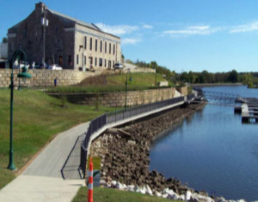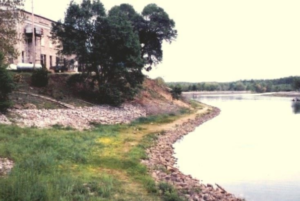Steamboat Landing
In Spring of 2010, the City of Warsaw began the first phase of construction on Steamboat Landing, a beautiful elevated boardwalk ten feet wide by approximately 1000 feet long.
History & Inspiration for Steamboat Landing
In the early to mid-1800s, Warsaw was a thriving river town. Seated on the Osage Arm of Lake of the Ozarks, Warsaw became a major year-round river port. Numerous steamboats lined the riverbank along the downtown, loading and unloading goods and passengers. It came to be known as Steamboat Landing.
The following article was written by the late Mayor and newspaper editor, MK (Jab) White.
“Steamboats: On a rocky ledge bordering the Osage in Lay Park, steamboat mooring rings can still be found. In the years before the Civil War, as many as a dozen would-be docked there at the same time. Unless the Osage Arm of Lake of the Ozarks was at flood stage, Warsaw was usually the farthest point upstream the boats could come after leaving the Missouri River. Most of the steamers had St. Louis as a home port. And what wonderful names these boats had! The Wave, St. Louis Oak, Lake of the Woods, The Mary Blane, Faraway, Gossamer, Pearl No. 2 and the Fire Canoe.
Coming to Warsaw, they brought cargoes of groceries, salt, nails, and iron. Going back, they took pork from hogs fattened on acorns, pelts and furs, barley, deer skins, dried fruit, ginseng, cigars, hemp, hoop poles, iron ore, lard, bee cords, wax, and whiskey. In March of 1850, The Wave arrived at St. Louis with a cargo including 301 venison hams from Warsaw. In 1854, Warsaw shipped out 144 bales of deerskin.
March to June and October to December were the best months for navigation, due to the seasonal rains. Usual speed, going upstream, was about five miles an hour. Speed doubled going back with the current to St. Louis. One of the largest boats to dock here was General Meade. She was 192 feet long and 29 feet wide. She carried a crew of forty, with deckhands to unload agricultural equipment. The coming of the narrow-gauge railroad in the 1870s was a death blow to the steamboat trade.”
Improvement Phases
Steamboat Landing has been reborn as a different type of boat anchoring. As part of a land and water trail system, this section of the trail behind the Community Building is a ten-foot-wide by approximately 1000 foot long boardwalk. Certainly, it has the capability to accommodate watercraft on the Lake of the Ozarks. Eventually, it will have the capacity to tie up 64 boats of various sizes. This provides the opportunity for immediate access to the downtown, waterfront and the ever-growing network of recreational trails.


